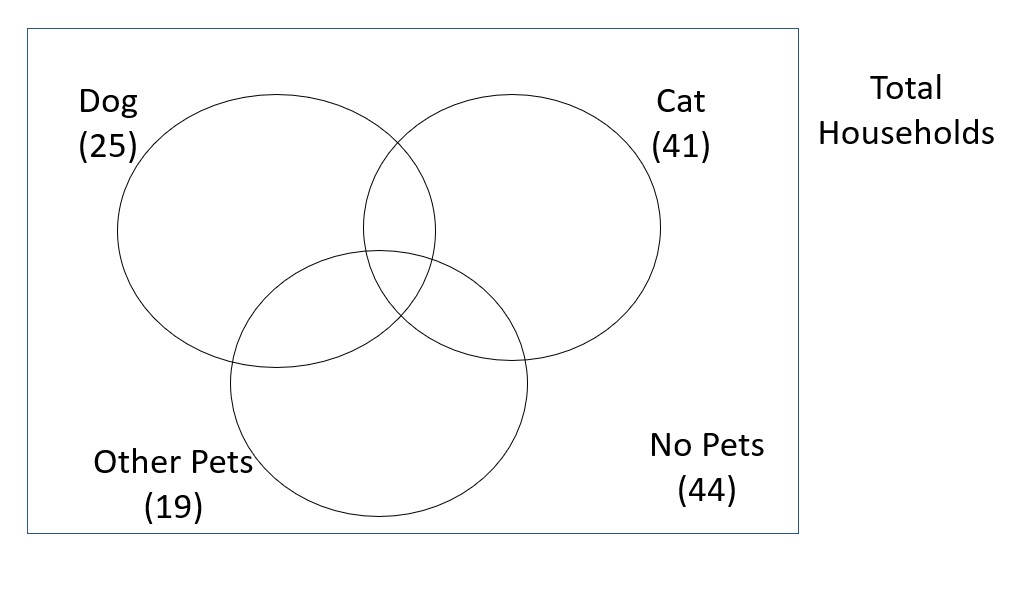
GRE Prep Club Daily Prep
Thank you for using the timer - this advanced tool can estimate your performance and suggest more practice questions. We have subscribed you to Daily Prep Questions via email.
Customized
for You
Track
Your Progress
Practice
Pays
Not interested in getting valuable practice questions and articles delivered to your email? No problem, unsubscribe here.
The total number of 85 households with at least one pet
[#permalink]
 05 May 2021, 02:04
05 May 2021, 02:04
Expert Reply
1
Bookmarks
Question Stats:
 44% (01:21) correct
44% (01:21) correct
 56% (01:02) wrong
56% (01:02) wrong  based on 25 sessions
based on 25 sessions
Hide Show timer Statistics
Attachment:
GRE The total number of households.jpg [ 42.13 KiB | Viewed 2844 times ]
Quantity A |
Quantity B |
The total number of households with at least one pet |
85 |
A)The quantity in Column A is greater.
B)The quantity in Column B is greater.
C)The two quantities are equal.
D)The relationship cannot be determined from the information given.
Kudos for the right answer and explanation
Question part of the project GRE Quantitative Reasoning Daily Challenge - (2021) EDITION
GRE - Math Book
Moderator

Joined: 02 Jan 2020
Status:GRE Quant Tutor
Posts: 1141
Given Kudos: 9
Location: India
Concentration: General Management
Schools: XLRI Jamshedpur, India - Class of 2014
GMAT 1: 700 Q51 V31
GPA: 2.8
WE:Engineering (Computer Software)
The total number of 85 households with at least one pet
[#permalink]
 20 Jun 2021, 01:46
20 Jun 2021, 01:46
1
kumarneupane4344
Refer Below Image

image.jpg [ 47.15 KiB | Viewed 2572 times ]
Now the catch in the problem is that a household can have only a dog, only a cat, only one other pet, or a combination of these. Like a dog and a cat, a dog and other pet, a cat and other pet or all of them also.
Now if they would have given that a household can have only one pet then total number of households will be number of dogs + number of cats + number of other pets = 25 + 41 + 19 = 85
But, that is not the case. So a household can have a combination of them also.
SO, the total number of households which have at least one pet will be <= 85
=> Quantity A <= Quantity B, which means that we do NOT have sufficient information to answer the question.
So, answer will be D
Hope it helps!
Refer Below Image
Attachment:
image.jpg [ 47.15 KiB | Viewed 2572 times ]
Now the catch in the problem is that a household can have only a dog, only a cat, only one other pet, or a combination of these. Like a dog and a cat, a dog and other pet, a cat and other pet or all of them also.
Now if they would have given that a household can have only one pet then total number of households will be number of dogs + number of cats + number of other pets = 25 + 41 + 19 = 85
But, that is not the case. So a household can have a combination of them also.
SO, the total number of households which have at least one pet will be <= 85
=> Quantity A <= Quantity B, which means that we do NOT have sufficient information to answer the question.
So, answer will be D
Hope it helps!
General Discussion
Re: The total number of 85 households with at least one pet
[#permalink]
 05 May 2021, 22:02
05 May 2021, 22:02
Consider this question in form of sets;
Set Dog, Set Cat, Set Other.
Now if you draw the three sets, you might understand there are many possibilities how they might intersect.
Case #1 :
All three sets are different from one another and do not intersect at all in which case the union and total number of distinctive households will be:
Dog U Cat U Other = 25 + 41 + 19 = 85;
Distinct households = 85;
Case #2 :
It might be possible that Cat is the biggest set which totally includes Dog and Other sets inside of it. In this case the distinct households would be equal to the set Cat:
Distinct households = 41;
More explanation on Case #2 : This happens because it is nowhere mentioned that one household cannot have more than one pet. It might be possible that out of the 41 households who own a cat, 25 also own a dog while 19 own other pets. Hence, the distinct households would only be 41.
This two cases are enough to get to the answer choice D.
Set Dog, Set Cat, Set Other.
Now if you draw the three sets, you might understand there are many possibilities how they might intersect.
Case #1 :
All three sets are different from one another and do not intersect at all in which case the union and total number of distinctive households will be:
Dog U Cat U Other = 25 + 41 + 19 = 85;
Distinct households = 85;
Case #2 :
It might be possible that Cat is the biggest set which totally includes Dog and Other sets inside of it. In this case the distinct households would be equal to the set Cat:
Distinct households = 41;
More explanation on Case #2 : This happens because it is nowhere mentioned that one household cannot have more than one pet. It might be possible that out of the 41 households who own a cat, 25 also own a dog while 19 own other pets. Hence, the distinct households would only be 41.
This two cases are enough to get to the answer choice D.







